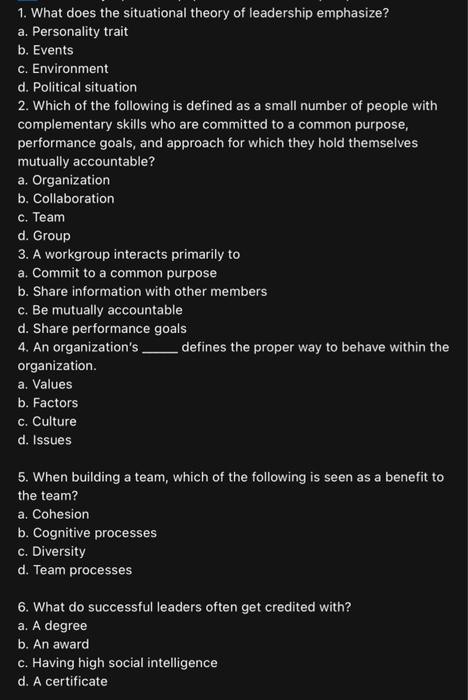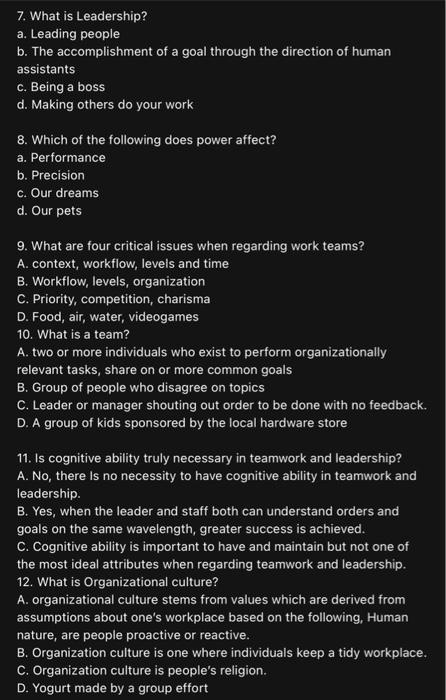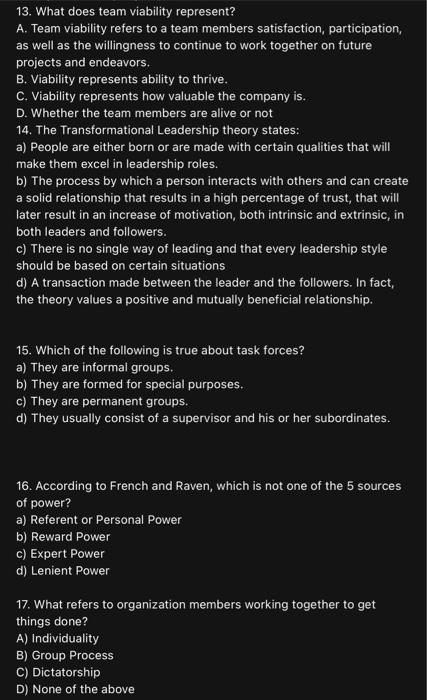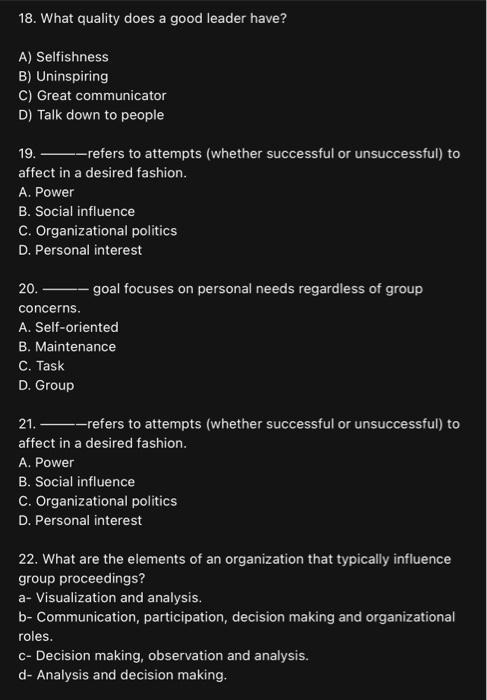Answered step by step
Verified Expert Solution
Question
1 Approved Answer
1. What does the situational theory of leadership emphasize? a. Personality trait b. Events c. Environment d. Political situation 2. Which of the following





1. What does the situational theory of leadership emphasize? a. Personality trait b. Events c. Environment d. Political situation 2. Which of the following is defined as a small number of people with complementary skills who are committed to a common purpose, performance goals, and approach for which they hold themselves mutually accountable? a. Organization b. Collaboration c. Team d. Group 3. A workgroup interacts primarily to a. Commit to a common purpose b. Share information with other members c. Be mutually accountable d. Share performance goals 4. An organization's defines the proper way to behave within the organization. a. Values b. Factors c. Culture d. Issues 5. When building a team, which of the following is seen as a benefit to the team? a. Cohesion b. Cognitive processes c. Diversity d. Team processes 6. What do successful leaders often get credited with? a. A degree b. An award c. Having high social intelligence d. A certificate 7. What is Leadership? a. Leading people b. The accomplishment of a goal through the direction of human assistants c. Being a boss d. Making others do your work 8. Which of the following does power affect? a. Performance b. Precision c. Our dreams d. Our pets 9. What are four critical issues when regarding work teams? A. context, workflow, levels and time B. Workflow, levels, organization C. Priority, competition, charisma D. Food, air, water, videogames 10. What is a team? A. two or more individuals who exist to perform organizationally relevant tasks, share on or more common goals B. Group of people who disagree on topics C. Leader or manager shouting out order to be done with no feedback. D. A group of kids sponsored by the local hardware store 11. Is cognitive ability truly necessary in teamwork and leadership? A. No, there is no necessity to have cognitive ability in teamwork and leadership. B. Yes, when the leader and staff both can understand orders and goals on the same wavelength, greater success is achieved. C. Cognitive ability is important to have and maintain but not one of the most ideal attributes when regarding teamwork and leadership. 12. What is Organizational culture? A. organizational culture stems from values which are derived from assumptions about one's workplace based on the following, Human nature, are people proactive or reactive. B. Organization culture is one where individuals keep a tidy workplace. C. Organization culture is people's religion. D. Yogurt made by a group effort 13. What does team viability represent? A. Team viability refers to a team members satisfaction, participation, as well as the willingness to continue to work together on future projects and endeavors. B. Viability represents ability to thrive. C. Viability represents how valuable the company is. D. Whether the team members are alive or not 14. The Transformational Leadership theory states: a) People are either born or are made with certain qualities that will make them excel in leadership roles. b) The process by which a person interacts with others and can create a solid relationship that results in a high percentage of trust, that will later result in an increase of motivation, both intrinsic and extrinsic, in both leaders and followers. c) There is no single way of leading and that every leadership style should be based on certain situations d) A transaction made between the leader and the followers. In fact, the theory values a positive and mutually beneficial relationship. 15. Which of the following is true about task forces? a) They are informal groups. b) They are formed for special purposes. c) They are permanent groups. d) They usually consist of a supervisor and his or her subordinates. 16. According to French and Raven, which is not one of the 5 sources of power? a) Referent or Personal Power b) Reward Power c) Expert Power d) Lenient Power 17. What refers to organization members working together to get things done? A) Individuality B) Group Process C) Dictatorship D) None of the above 18. What quality does a good leader have? A) Selfishness B) Uninspiring C) Great communicator D) Talk down to people 19. affect in a desired fashion. refers to attempts (whether successful or unsuccessful) to A. Power B. Social influence C. Organizational politics D. Personal interest 20. goal focuses on personal needs regardless of group concerns. A. Self-oriented B. Maintenance C. Task D. Group 21.-refers to attempts (whether successful or unsuccessful) to affect in a desired fashion. A. Power B. Social influence C. Organizational politics D. Personal interest 22. What are the elements of an organization that typically influence group proceedings? a- Visualization and analysis. b- Communication, participation, decision making and organizational roles. c- Decision making, observation and analysis. d- Analysis and decision making. 23. What are some qualities of great leaders? a. Effective communication skills, self-awareness, vision, empathy, and responsibility. b. Self-centered, unpredictable, smart, self-confidence. c. Effective communication, selfishness, self-confidence, and honesty. d. Adaptability, intelligence, good communication skills and arrogance. 24- How can we describe The Trait Theory of Leadership? a- Analyses the personality of each individual to understand their behavior. b- Identify physical characteristics that distinguish leaders from non- leaders c- Analyzes mental, physical, and social characteristic to understand what the characteristic or the combination of characteristics that are common among leaders. d- Identify social characteristics that distinguish good leaders from bad leaders. 25- Team learning refers to: a- A strategy to ensure good communication between groups in an organization. b- Sharing information between individuals to directly report an answer to the team leader. c- A mechanism in which an expert teaches new strategies onto others. d- The collaborative effort to achieve a common goal within the group. 26. One of the easiest aspects of group process to observe is the pattern of a. Communication b. Work progress c. Professionalism d. Hanging out at lunch 27. Successful leaders are often accredited by and are good leaders because they have a. Ability to embrace change b. Ability to command people c. Power and money d. Nice haircuts
Step by Step Solution
★★★★★
3.42 Rating (158 Votes )
There are 3 Steps involved in it
Step: 1
1 The situational theory of leadership emphasizes the environment events and political situation as key factors in determining the best method for leading a group or organization This theory states th...
Get Instant Access to Expert-Tailored Solutions
See step-by-step solutions with expert insights and AI powered tools for academic success
Step: 2

Step: 3

Ace Your Homework with AI
Get the answers you need in no time with our AI-driven, step-by-step assistance
Get Started


